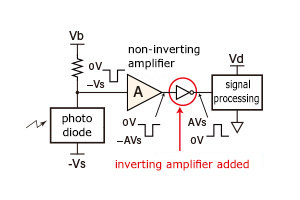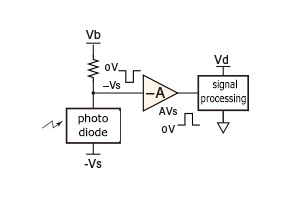- HOME
- > Multi channel amplifier : Function Description

|
|
Function Description
|
|
Various settings are available for signal process systems and sensor signals. |
| Following functions can be set by simply using a switch, no additional component is needed. | |||||||||||||||||
|
 |
||||||||||||||||
|
Input
Coupling
DC/AC
|
| Some sensors that operate with single power supply (e.g. Pyroelectric sensor) have large DC bias compared to the actual sensor signal. In this case, directly inputting sensor signal to the amplifier would result in voltage saturation to power supply which is caused by this large DC bias, where in that case the actually sensor signal cannot be observed. | ||
|
|
||
|
▼
As for NF multi-channel low noise amplifier,
This product can change DC/AC input mode by toggling the switch. DC
mode is appropriate for any small measurement within ±0.1 V. When
the output of the amplifier is saturated by large DC bias over ±0.1
V, the DC bias can be eliminated by selecting AC mode, so that the
detection of the actual signal can then be observed.
|
||
|
|
||

DC mode |

AC mode |
|
|
|
Phase
Inversion
Available for In-phase / Out-of-phase mode
setting (single-ended only)
|
| Signal phase inverting works in various situations. | ||
|
|
||
|
▼
As for NF multi-channel low noise amplifier,
This product contains the switch for selecting in-phase and
out-of-phase in single-ended input mode.
For example, signal processing can be accomplished without using an additional inverting amplifier for those systems that cannot process negative voltage signal. |
||
|
|
||

when negative voltage signal cannot be processed |

when this product is set as an inverting amplifier |
|
|
|
Input
Mode
differential / single-ended
|
|
Choosing differential input type or single-ended input type based on
measurement objects, it is important to reproduce the amplified signal
accurately. For example, when measuring a current with a shunt resistor, the detection circuit input will be changed based on the position of the shunt resistor if it is at high-side or at low-side. For the low-side detection circuit, both single-ended and differential input types can be used, but single-ended is commonly used due to its easy wiring connection. When wiring length becomes longer, differential input type is recommended, since the differential is tolerant to common mode noise. Meanwhile, differential input type is always needed for high-side detection circuit, because both shunt resistor ends are floated from ground. |
||
|
|
||
|
▼
As for NF multi-channel low noise amplifier,
The input mode of this product can be switched based on
corresponding situations.
|
||
|
|
||
 Single-ended input type is commonly used due to its easy wiring connection. But when wiring length becomes longer, differential input type is recommended, because the differential is tolerant to common mode noise. low-side detection |
 Required differential input measurement high-side detectionr |
|
|
|
AMP
GND
FLOAT/EXTERNAL
|
|
Generally noise characteristics show better performance when "Float setting"
is chosen (amplifier GND is separated from earth ground). However, there are cases where "External setting" has better noise characteristics based on measurement ambient and/or measurement systems (amplifier GND is connected to earth ground). |
||
|
|
||
|
▼
As for NF multi-channel low noise amplifier,
This product can easily be switched between FLOAT and EXTERNAL,
simply confirm the desired setting.
|
||
|
|
||

GND setting: FLOAT |

GND setting: EXTERNAL |
|
| For example: post-amplifier (gain 60dB, frequency range: 0.1Hz to 1kHz) | ||
|
*July 31, 2018 |
||
|

 Input
Coupling: DC/AC
Input
Coupling: DC/AC

 A-GND
A-GND -B-GND
-B-GND